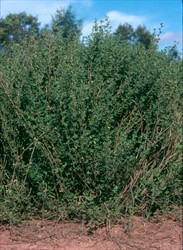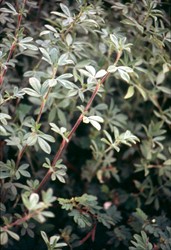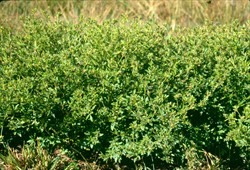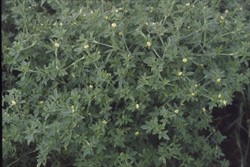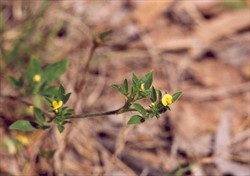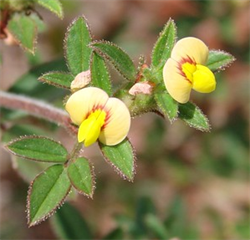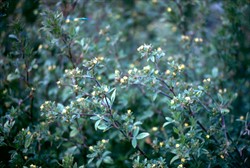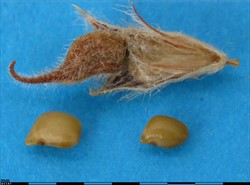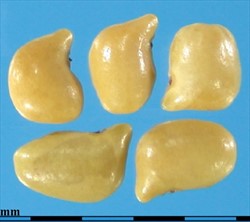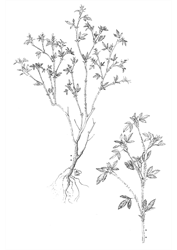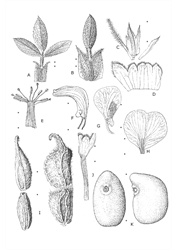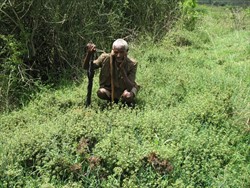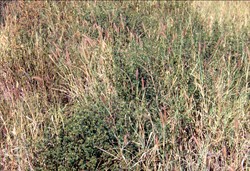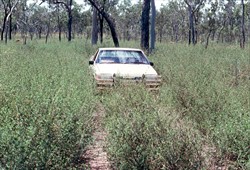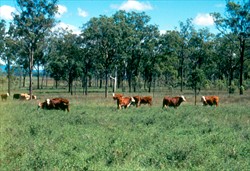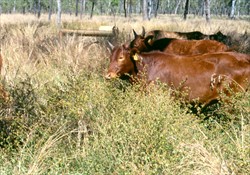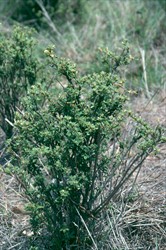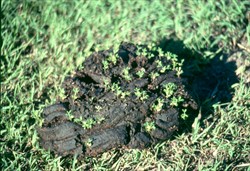Stylosanthes scabra
Tropical Forages
Stylosanthes scabra Vogel
Stylosanthes nervosa J.F. Macbr.; Stylosanthes suffruticosa Mohlenbr.; Stylosanthes tuberculata S.F. Blake
Family: Fabaceae (alt. Leguminosae) subfamily: Faboideae tribe: Dalbergieae subtribe: Stylosanthinae.
Erect to sub-erect shrubby perennial to 2 m tall, with strong, deep taproot (to 4 m). Young stems vary from green to reddish in colour, depending on the strain; usually with dense hairs and bristles, and viscid, becoming woodier with age. Leaves trifoliolate; leaflets hairy on both surfaces, elliptic to oblong-lanceolate, apex obtuse to acute, minutely mucronate, pale green to dark green and dark blue-green in colour; terminal leaflet 20‒33 mm long, 4‒12 mm wide; lateral leaflets smaller; petiole to 10 mm long, canaliculate above, scabrous with dense short hairs, the rachis 4‒5 mm long; stipules obovate, 15‒25 mm long including teeth, bristly-hairy. Inflorescence an axillary or terminal, shortly elongate, obovoid to ellipsoid spike, 1‒3 cm long, comprising several pale to darker yellow flowers, each flower surrounded by a bract and 3 bracteoles; bracts unifoliolate, the blade about 4 mm long, the sheath 3.5‒6.5 mm long with long teeth; outer bracteole 2‒4.5 mm long, bifid and ciliate at apex; axis rudiment 4‒5 mm long; inner bracteoles 2‒4 mm long, ciliate at apex; calyx tube 3‒6.5 mm long, lobes 1.5‒3.5 mm long; standard suborbiculate, ca. 7 mm long. Fruit a 2-segmented pod (lomentum), both segments usually fertile; the upper segment 4‒5 mm long (including recurved beak or hook 1‒2 mm long), 2.5 mm broad, reticulately veined, shortly hairy; and the lower segment 2‒3 mm long, evenly pilose; seeds asymmetrically reniform, to 2 mm long, fawn to light brown. 400,000‒500,000 seeds-in-pod and 600,000‒800,000 dehulled seeds per kg.
Two major types recognised in northern South America:
1) Brazilian coastal type from higher rainfall districts close to coast - late flowering, taller, more erect, higher yielding, often most anthracnose resistant.
2) Continental type from Colombia, Venezuela and central Brazil - early flowering, shorter, semi-erect, less vigorous, more anthracnose susceptible; often reddish stems.
Accessions collected in northern Argentina and identified by R. Vanni as S. scabra, are low growing, fine stemmed, and early flowering (January/February at 17º S), bearing a stronger resemblance to S. guianensis var. intermedia than to the shrubby types of S. scabra of northern South America. They appear to be free of anthracnose.
English: shrubby stylo, scabrous stylo (Australia); pencilflower (USA)
Asia: stylo perduan (Indonesia); muyal masal (Tamil, India); നിലത്തുവര nilaththuvara (Malayalam, India)
Latin America: poha po'i, sai po'i (Angaité, Paraguay); alfafa do nordeste (Brazil); Capitán Juan, pata de terecay (Venezuela)
Native:
Caribbean: Bahamas; Cuba
South America: Argentina (Jujuy, Salta); Bolivia; Brazil (Bahia, Goiás, Mato Grosso, Mato Grosso do Sul, Minas Gerais, São Paulo); Colombia; Ecuador (Loja); Guyana; Paraguay; Peru (Cajamarca); Venezuela (Anzoátegui, Federal District, Guárico, Lara, Mérida, Miranda, Monagas, Portuguesa, Sucre, Táchira, Trujillo, Yaracuy)
Cultivated/naturalized:
Africa: Kenya; South Africa
Asia: India
Australasia: Australia (Northern Territory, Queensland)
Forage
Mainly used as perennial pasture, in association with sown and native grasses. Used for cut-and-carry in some countries. Young regrowth has qualities that suggest value for fodder conservation. Can be used in silvipasture under moderate shade.
Other
Used for fertility regulation in Angaité folk medicine in Paraguay. Has acaricidal properties, with the lethal effects on larval and nymphal ticks of Rhipicephalus sanguineus, Rhipicephalus (Boophilus) microplus and Haemaphysalis intermedia.
Soil requirements
Well adapted to infertile, acid, friable or hard-setting, sandy-surfaced soil; not as well adapted to heavier textured, less acid soils, and not suited at all to heavy clays.
Moisture
An extremely drought hardy species, occurring in areas with rainfall as low as 350 mm/yr. While there have also been collections from areas with rainfall up to 2,650 mm/yr, the majority of collections come from areas receiving 700‒1,600 mm/yr. In cultivation, it has mainly been used in areas with an annual rainfall 600‒900 (‒2,000) mm. Long dry seasons can be a limiting factor in areas with low rainfall and shallower soils, where annuals, or perennials with the capacity to act as annuals (e.g. S. hamata), are more successful. Seedling growth is usually too slow in S. scabra for it to act as an annual. Some types at least are not very tolerant of waterlogging, although some variation between genotypes may exist.
Temperature
Overall, found between 11.3º N (Venezuela) and 24.6º S (Argentina), in an implicitly wide range of temperature regimes according to latitude and elevation (from 4.45º N at 250 m asl to 18.3º S at 2,000 m asl to 24.6º S at 1,400 m asl). All are summer-growing perennials, some ecotypes possessing moderate frost tolerance. Cultivars remain green following light frosts, the crowns surviving heavier frosts. Very heavy frost can kill plants.
Light
Appears to have moderate shade tolerance, growing successfully under coconuts and developing rubber.
Reproductive development
Primarily a short-day flowering response, with other factors such as juvenility influencing flowering time. Critical photoperiod lies between 11.5 and 12.5 hours depending on ecotype. In northern Australia, flowering dates vary from mid-January to mid-May.
Defoliation
Seedlings are very slow growing for the first season, but are particularly hardy and able to establish unless grass competition is strong. Regrowth following grazing is normally from buds along the aerial stems, which, being hard and woody, are rarely removed. When mown, strong and rapid regrowth occurs from crown buds at or even slightly below ground level. If mature plants are cut very low, regrowth is slow and plant death may result. Normally S. scabra is continuously but lightly grazed. Under extensive conditions, animals tend to ignore the shrubby stylos until late in the growing season.
Fire
'Seca' plants are very susceptible to fire. Early season burning during the first 3 years or so following sowing can eliminate 'Seca' from the pasture. Once the stylo is established, fire can be used to control legume dominance of the stand. The legume component regenerates with the first rains through softening of hard seed by the fire, but this relies on having a bank of soil seed. Plants surviving the fire regrow rapidly from the low-set crown or from root tissue down to 38 mm below the soil surface.
Guidelines for establishment and management of sown forages.
Establishment
Embryo dormancy in fresh seed declines rapidly. The main restriction to germination is hard seededness, which may be as high as 70‒90% in freshly harvested seed. Natural breakdown of hard seededness is brought about by exposure to soil surface temperatures of 50‒55 ºC. In the seasonally dry tropics, dry season soil surface temperatures are sufficient to soften seed in readiness for the first rains. When rapid germination and establishment of a proportion of the seed is desirable, various scarification treatments have been developed, often involving dry heat. Recommendations vary from 1‒2 hours at 85 ºC in a heated oven to 15‒30 seconds on a hot surface at 140‒150 ºC, in each case cooling to ambient temperature. Since heat treatments can damage seed, the safest and most practical way of scarifying seed is to use an appropriately-set hammer mill, which de-hulls and scarifies about 50% of the seed. Seed is sown at 1‒2 kg/ha. Shrubby stylo seedlings tend to be weak and slow growing during the first season. Inoculation is not essential since S. scabra nodulates readily with a wide spectrum of rhizobium strains, but use of CB 82, a strain proven effective on this species, provides a measure of insurance.
Fertilizer
While able to establish and persist on low phosphate soils, S. scabra responds to applications of 10‒20 kg/ha P on such soils. This is of benefit to both plant and animal. Sulphur and potassium responses have also been obtained on infertile soils.
Compatibility (with other species)
Once established, S. scabra can persist with many of the grasses that grow in the same environment. Also competes with many lower growing weed species, but not with taller-growing, unpalatable species such as Chromolaena odorata.
Companion species
Grasses: Bothriochloa bladhii, Cenchrus ciliaris, Digitaria milanjiana, Heteropogon contortus, Urochloa mosambicensis.
Legumes: Aeschynomene americana, Chamaecrista rotundifolia, Listia bainesii, Stylosanthes hamata, S. guianensis var. intermedia.
Pests and diseases
Variable susceptibility to anthracnose disease caused by Colletotrichum gloeosporioides and C. dematium - controlled by use of resistant varieties. Head blight caused by Botrytis cinerea, can be a problem in seed crops in years with overcast weather during flowering. Sclerotium blight caused by Corticium (Sclerotium) rolfsii and sclerotinia stem rot caused by Sclerotinia sclerotiorum can kill plants when environmental conditions favour their development. A disease often referred to as "reversion" (reverts from reproductive to vegetative state) caused by a phytoplasma, has become a major problem in seed crops. It occurs late in the season, producing elongation of inflorescences and interfering with seed set, ultimately killing plants. It is carried by a leafhopper (Erosius sp.) and affects a range of other species in the seed production area. The condition also occurs in pasture plantings but is much less severe. Violet root rot caused by Rhizoctonia crocorum (teleomorph Helicobasidium) has led to stand reduction of epidemic proportions in the sub-humid subtropics during cool, wet conditions.
Stem borers, the larvae of Caloptilia sp. (Lepidoptera: Gracillariidae) in Brazil and Colombia, and Platyomopsis pedicornis (Coleoptera: Cerambycidae) can cause significant damage in pastures and seed crops.
Ability to spread
Spreads through ingestion by cattle and by water movement. The hairy and/or hooked pod segments can also adhere to animal fur.
Weed potential
Has caused concern with legume dominance of pastures and consequent acidification of poorly buffered soils in northern Australia. While not officially declared, it is viewed as an environmental weed in such areas.
Nutritive value
Nutritive value declines with age, leaf CP from 20 to 10%, P from 0.3 to 0.1% and IVDMD from 70 to 50%. ADF values of about 30 % in the leaf, and 43% in the stem of the terminal 15 cm of shoots have been measured. Proportion of stem increases with age, from about 20% early in the growing season to 75% at the end of the season (and higher in grazed pastures). This varies considerably with ecotype. Often need supplementary P to achieve best animal performance. Na levels are much higher than those for many other tropical legumes and may be 1‒2 % of DM in leaf and stem.
Palatability/acceptability
Generally low palatability, the grass being grazed preferentially in the early part of the growing season.
Toxicity
There is no record of toxicity to livestock.
Dry matter
Dry-matter yields on poor soils in a low rainfall area may be less than 1 t/ha, but up to 10 t/ha under more ideal conditions. In grass/legume pastures it can contribute 2‒7 t/ha DM.
Animal production
Annual liveweight gains of 140‒160 kg/hd can be achieved from grass/legume pastures.
2n = 40 chromosomes, 98% self-pollinating. S. scabra is an allotetraploid species (2n = 40) with a putative diploid A genome progenitor S. hamata or S. seabrana (2n = 20) and the B genome progenitor S. viscosa (2n = 20), the event taking place 0.63 to 0.52 million years ago. Breeding programs have been undertaken to develop multiple-gene resistance to anthracnose disease.
Seed can be hand or machine harvested. Because of the span of flowering time, peak seed yields can span a period of 3‒4 weeks. For machine harvest, seed recovery is favoured by using a machine with a small front, high horsepower, slow groundspeed and large sieve area. Also best to harvest during low humidity conditions when seed is less sticky, and when seed in the head has not been dislodged by recent strong winds. In northern Australia, seed is normally harvested during the dry season. Suction harvesting is possible, but rarely economical. Irrigated crops are harvested in August-September, and rain grown crops, a month earlier. In the past, seed stands were retained for as long as possible, but needed renovation after 2‒4 years, as older plants became moribund. Seed crops are now treated as annuals due to the emergence of a phytoplasma disease (often referred to as "reversion"), which tends to attack plants in the second year after sowing. Seed is sown early each season and the crop irrigated to ensure rapid development and earlier floral initiation. If harvesting is delayed beyond the cooler part of the dry season, incidence of "reversion" increases. Trash is destroyed by burning or incorporation into the soil following harvest to reduce phytoplasma in the system. Yields of seed-in-pod vary from 100 to 700 kg/ha, mostly 300‒400 kg/ha.
Herbicides are largely used for seed production only. Trifluralin and 2,4-D are safe and effective in establishment. Also tolerant of bentazone and fluazifop-butyl, but not acifluorfen.
- Widely adapted.
- Drought tolerant.
- Well suited to low P soils.
- Well suited to extensive grazing systems.
- Threat of anthracnose .
- Low palatability (may also be an advantage).
- Not adapted to heavy clay soils.
- Can become dominant if not managed.
- Poses some weed risk.
Chakraborty, S. (ed). (2004) High-yielding anthracnose-resistant Stylosanthes for agricultural systems. ACIAR Monograph No. 111. Australian Centre for International Agricultural Research (ACIAR), Canberra, Australia. aciar.gov.au/node/8471
Edye, L.A. and Maass, B.L. (1997) Recent advances in studies of anthracnose of Stylosanthes. I. The biogeography of Stylosanthes hamata, S. scabra and "Stylosanthes seabrana". Tropical Grasslands 31:417–423. bit.ly/2mqiT4n
Edye, L.A. and Topark-Ngarm, A. (1992) Stylosanthes scabra Vogel. In: Mannetje, L.’t and Jones, R.M. (eds) Plant Resources of South-East Asia No. 4. Forages. Pudoc Scientific Publishers, Wageningen, the Netherlands. p. 219–221. edepot.wur.nl/327785
Marques, A., Moraes, L., Santos, M.A. dos, Costa, I., Costa, L., Nunes, T., Melo, N., Simon, M.F., Leitch, A.R., Almeida, C. and Souza, G. (2018) Origin and parental genome characterization of the allotetraploid Stylosanthes scabra Vogel (Papilionoideae, Leguminosae), an important legume pasture crop. Annals of Botany 122(7):1143–1159. doi.org/10.1093/aob/mcy113
Orr, D.M. (2010) Managing the grass-legume balance in Stylosanthese scabra cv. Seca pastures in central Queensland. Tropical Grasslands 44:174–183. bit.ly/2wUxLx5
Stace, H.M. and Edye, L.A. (eds). (1984) The biology and agronomy of Stylosanthes. Academic Press, Sydney, Australia. doi.org/10.1016/B978-0-12-661680-4.X5001-X
Vanni, R.O. and Fernandez, A. (2011) The true identity of Stylosanthes seabrana B.L. Maass & L.’t Mannetje (Leguminosae Papilionoideae). Caryologia, 64:247–250. doi.org/10.1080/00087114.2011.10589789
'Fitzroy' (CPI 40205) Released in Australia (1980). From Cruz Das Almas, Bahia, in eastern Brazil (12°S, 36 m asl, rainfall c. 1,150 mm). Vigorous, erect, somewhat spreading plant, 1.5‒2 m tall, with green stems. Selected as an earlier flowering, leafier alternative to 'Seca' for use in the sub-humid subtropics. Proved to be susceptible to type A anthracnose. Now rarely planted, even in drier areas where anthracnose is not a problem, because commercial seed is not available.
'Seca' (CPI 40292) Released in Australia (1977). Origin Pernambuco, north-east Brazil, (8.13° S, 35.30° W, 300 m asl, rainfall 800 mm, 7 month dry season). Vigorous, erect plant, to 2 m tall, with reddish stems and open canopy . Widely adapted. Single gene resistance to anthracnose.
'Siran' Released in Australia (1990). Composite of 3 bred or selected lines ('Jecuipe', 'Recife', 'Feira') to provide multiple-gene resistance to anthracnose. Generally similar in appearance and adaptation to 'Seca'.
'Siran' components:
'Feira' Bred in Australia (1990). F5 selection of the cross, Q10042 × CPI 55860. Resistant to races 1, 3, and 4 of Colletotrichum gloeosporioides causing Type A anthracnose disease. Shortest of 'Siran' components. Flowers earlier than 'Seca' but later than 'Recife'; has more tertiary branches than 'Fitzroy' and 'Seca'.
'Jecuipe' Bred in Australia (1990). F5 selection of the cross Q10042 × CPI 93116 . Resistant to races 1, 3, and 4 of Colletotrichum gloeosporioides causing Type A anthracnose disease. Flowers earlier than 'Seca' and slightly later than 'Recife'. Plants are shorter than those of 'Seca' or 'Recife'. Has denser tertiary branching than 'Seca' or 'Fitzroy'.
'Recife' Bred in Australia (1990). Selection from genetically variable population of 'Seca'. Resistant to races 1 and 4, and moderately resistant to race 3 of Colletotrichum gloeosporioides, which cause Type A anthracnose disease. Early flowering and intermediate height, plants being taller than those of 'Jecuipe' and 'Feira' but shorter than of 'Seca'.
CPI 110116 Selected in Australia. Origin Táchira, Venezuela (7º47' N, 867 m asl, rainfall 1,189 mm). Low growing vigorous type with minimal anthracnose.
ILRI 11604 (CIAT 1068) Selected at Pretoria, South Africa. Origin Mucuri, Bahia, Brazil (18º S, 39 m asl, rainfall 1,583 mm). Selected for productivity, persistence and palatability.
